Between Thursday and Monday I went from a World Bank workshop in Lima on deforestation to 900 km away, slogging my way along rainforest trails next to the upper Madre de Dios River, contemplating the impact of deforestation on Banded Antbirds. OK, that may be a bit contrived, even for me! Let me take a step backward.
I have a consulting contract with the World Bank to assist the government of Peru to better approach the problem of deforestation. Traditionally, the forestry agency (SERFOR) just works on issues that they can directly control as part of their mandate and responsibilities, such as logging, concessions, and plantations. Unfortunately, deforestation almost entirely results from sectors outside of forestry, such as agriculture, mining, and transportation, so nobody is responsible for looking at the bigger picture. Deforestation in Peru is largely about the forests of the Amazon, as the Andean forests have already been extensively depleted. Deforestation rates are actually pretty low in the Peruvian Amazon because of the vast size of the forests and the low population but it’s important to start reversing trends now, before the situation seriously worsens. Current forest loss in Peru is about 120,000 ha/year. The World Bank in Peru is using its convening and financial powers to nudge a whole range of agencies to work together on tackling deforestation. Personally, I nudge and direct the nudgers – a team of forestry experts also contracted by the Bank, and together with our partners in SERFOR, we are helping to reshape national thinking on deforestation. Our workshop on 30 November 2023 was to move Peru toward net zero deforestation — recognizing that some deforestation is OK but always needing to be compensated by reforestation or afforestation so that the net area of forests is stable. Noble aspirations – the best kind.
There are four Amazonian forest ecoregions in Peru. By that Monday, I was visiting the Southwest Amazon Moist Forests which covers about half of the Peruvian Amazon and also extend into Brazil and Bolivia. Specifically, I was spending four days exploring the paths of the Los Amigos Biological Research Station. The station, in an area of extensive and pristine forests, is famous for biological research on primates but also on birds and many other topics.
What was I looking for? I was seeking the serenity of walking in a tropical rainforest with Screaming Pihas. I was also looking for a Banded Antbird, Dichrozona cincta, which was not bringing me tranquility and was stressing me out! My latest birder “thing” is to spin the wheel and choose completely at random a bird from the 7000 bird species in the world I have not seen. Wild goose chases gone overboard. My third global chase target is the Banded Antbird. It got randomly selected a year ago after I managed to get a glimpse of #2, the Puna Tapaculo, by chance also from Peru (more on that adventure some other time). The Banded Antbird is everywhere an uncommon species but it has a wide distribution throughout the Amazon. Most of its range is thus in Brazil but life this time took me not to Brazil but to Peru.
The Thamnophilidae, the family of “typical antbirds” is a large group of 237 species, exclusive to the neotropics. Not a single species has made it across the wall at the US border. They tend to have patterned plumages dominated by black, white, gray, and brown and to have striking loud songs. Some have quite beautiful plumages, like the Banded Antbird, black-spotted below and with striking beige bands on the wings and a band on the back (white in the male, brown in the female). The illustration here is of the male, from Birds of the World.
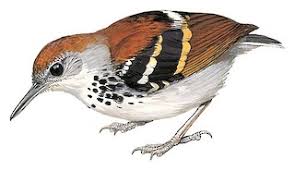
It occupies an interesting ecological niche. Unlike most antbirds which forage in the mid-canopy to understory, this species prefers to slowly walk along the forest floor. It bobs and weaves a bit, like a pipit, flicks its wings, and fans its tail. Its a tiny species, about the size of a Pacific Wren. It has a haunting call — a long series of rising and accelerating clear whistles. When you are hard to see, you have to be easy to hear! Because of its distinctive appearance and behaviour, it is not considered to be closely related to any other antbird; it’s the only member of the genus Dichrozona.
The person who enabled me a glimpse of the secretive Puna Tapaculo was the extraordinary Peruvian bird guide, Alex Durand Torres, of Peruvianbird.com. It doesn’t seem possible to know every sound made by the 1800+ species of Peruvian birds but I haven’t heard a peep yet that he has not been able to nail! His new mission impossible, which he elected to accept, was to find me a Banded Antbird among the cacophony of 600 bird species that have been recorded in the Los Amigos area. We flew separately into Puerto Maldonado and met up there, a drab Amazonian city whose only redeeming feature is that the roads leading out of town are paved. We took one for an hour to its end, and then went by boat 4 hours up the legendary Madre de Dios (Mother of God) River to the research camp. The boat trip was most notable for the views of the incredible destruction that has been wrought by illegal artisanal gold miners — pretty well the entire banks of both shores have been consumed by rough sluicing machines and spat into endless rows of mounds.
But the Los Amigos station is an area of amazing pristine forests in a conservation concession that is well guarded from intruders. There is a reason primatologists have trooped to this area for decades. It hosts eleven species of monkeys and because they are not hunted, are somewhat approachable. In my four days here, one of which was rained out, I saw five species including those below: a Weddell’s Saddle-backed Tamarin (Leontocebus weddelli) and the other-worldly Saki Monkeys (Pithecia).
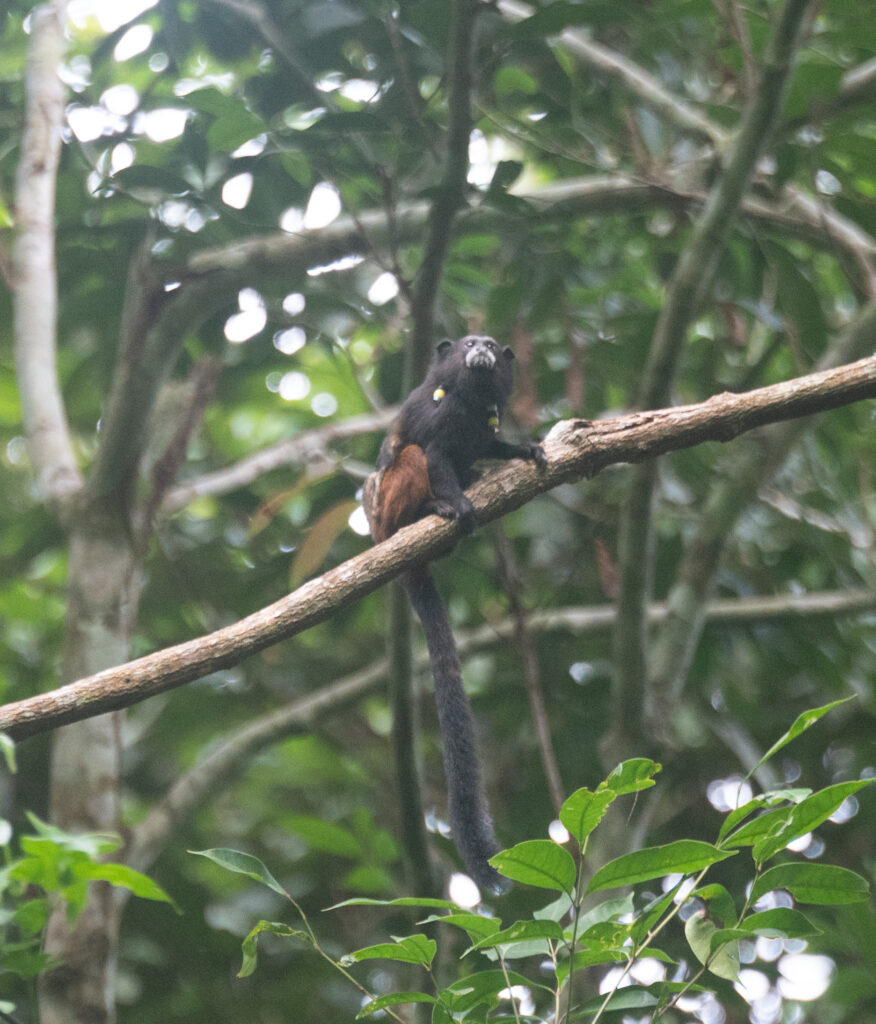

We ended up seeing or (mostly) hearing about 125 bird species, including no less than 20 from the antbird family! About 75 lifers for me, zero for Alex. Some birds (well, a handful or so…), I even found and identified myself. A few of my photos are below, including Golden-collared Toucanet (Selenidera reinwardtii), a rarely-photographed Lined Forest Falcon (Micrastur gilvicollis), probably looking for Banded Antbirds, and a Pale-winged Trumpeter (Psophia leucoptera).
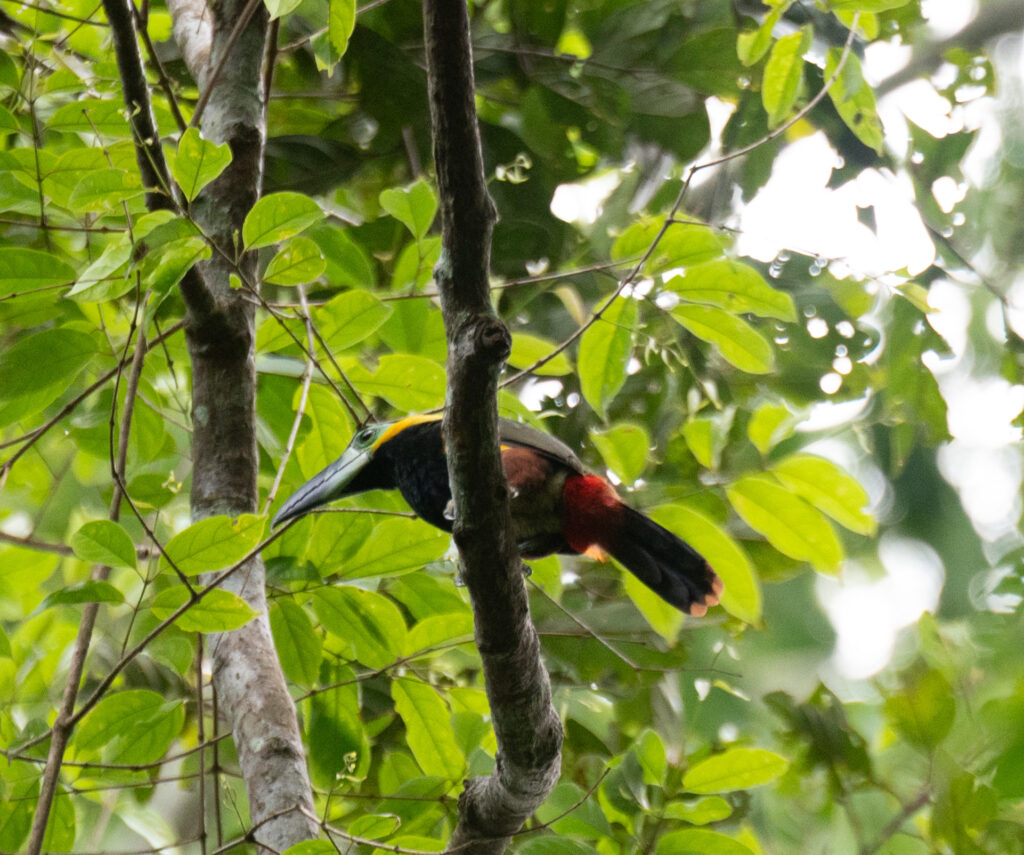
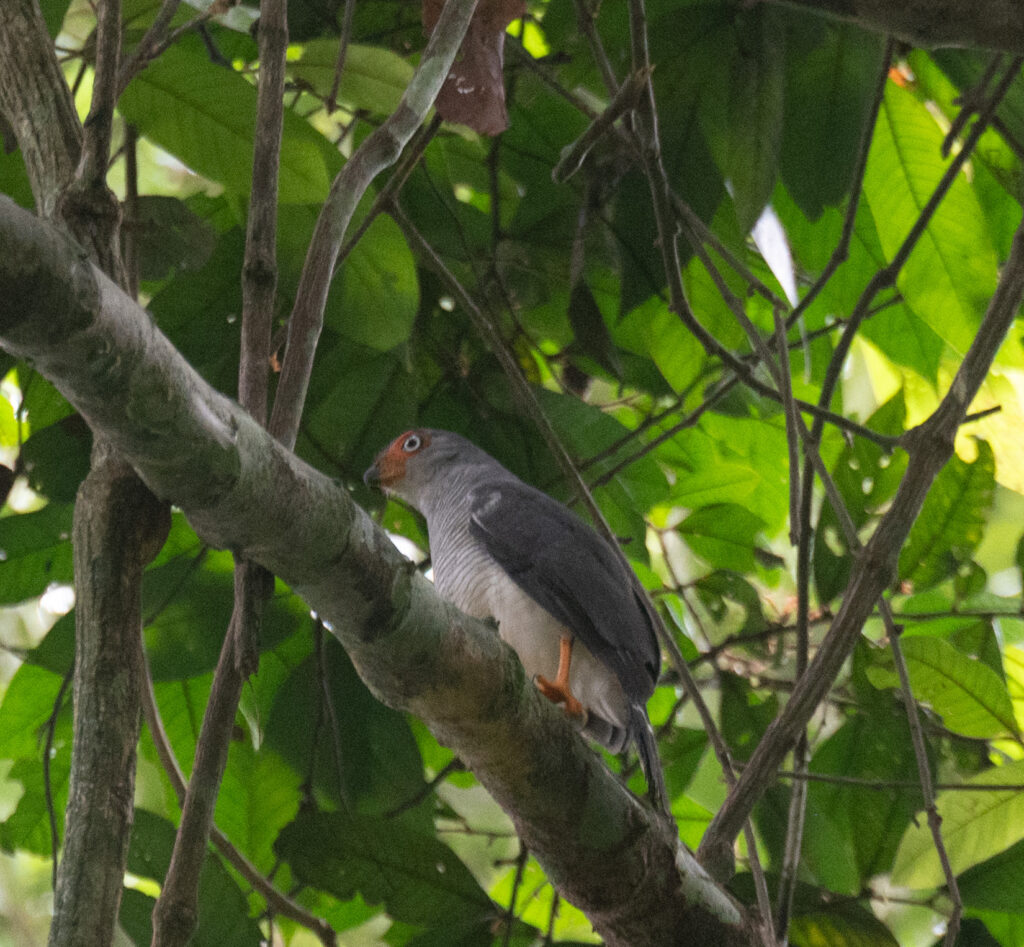
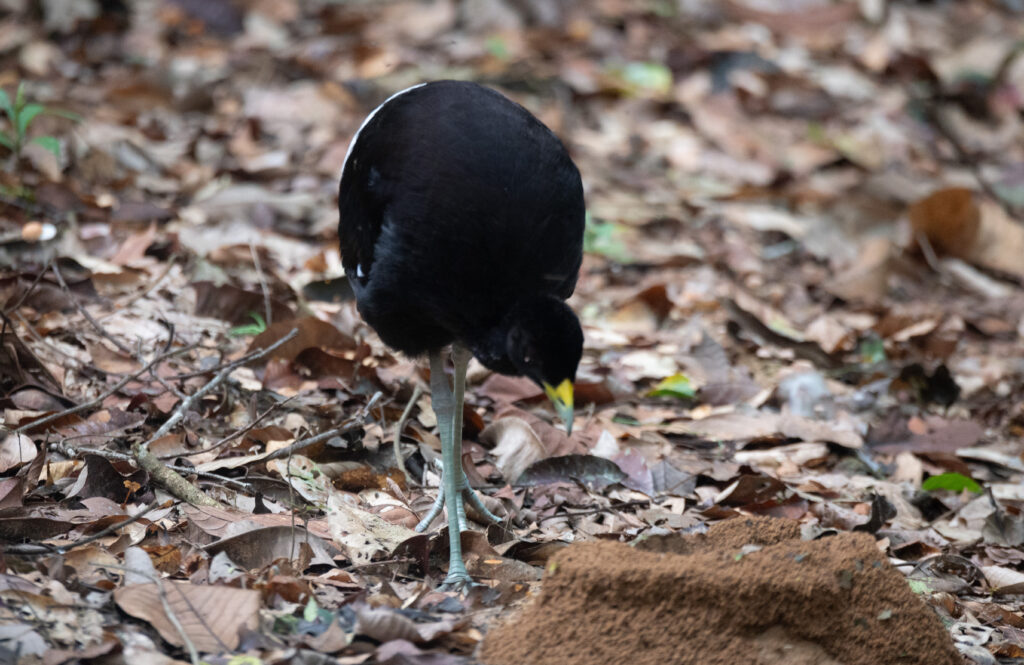
We walked about 25 km of forest trails, playing the song of the Banded Antbird in spots of propitious habitat – open old-growth forest with thick leaf litter. I scoured the forest floor looking for a little midget of a bird out for a stroll. Alex said he quite easily records it on all his trips into Los Amigos. Ditto for the resident ornithologist who said “Don’t worry, you’ll see it for sure”. But it was not to be! We figured they were most likely on nests or with fledglings so not vocalizing or responding to their calls. Indeed, the eBird bar chart for the species at the station shows them as being recorded throughout the year but with a reduced frequency in November and December as compared to the prior months. Hmm, sounds like a good excuse for another visit at some other time of the year!
So is deforestation threatening Banded Antbirds in Peru? No, the species is widespread and there are lots of Amazonian forests left, many of them well protected in conservation areas. But if Peru can advance toward net zero deforestation, that would help keep its habitat intact for the long-term and ensure its future. I’m not going to comprehensively dive in here into the complicated politics and policies of how to slow deforestation but let me mention one that is important — land titling. The Bank and lots of forestry experts agree that one of the most important steps to minimize deforestation is providing peasants and native communities with clear title to the lands they occupy and farm. With ownership comes incentives to invest in more sustainable farming approaches (minimizing the need for constant expansion into forests) and incentives to manage forests for the long-term, as opposed to just yielding to illegally operating timber companies that cut and run. Seems simple but it’s not. Giving titles requires the right laws and policies, adequate staffing and financing for land tenure authorities, control of corruption, inter-ministerial collaboration, and many other stars that have to be aligned. Hopefully the needed policy shifts and the needed investments on the ground will result from Peruvians converging in their thinking about how to manage their forests.
Thank you for sharing your story of the important work you are doing in Peru, and of your adventures at the Los Amigos station. It is hardly imaginable to walk in forest and see and hear tamarins and monkeys, and so many birds. I loved your photos. Not seeing the banded antbirds can only be seen as a sign that you do indeed need to return to this special place; save some room in your suitcase!